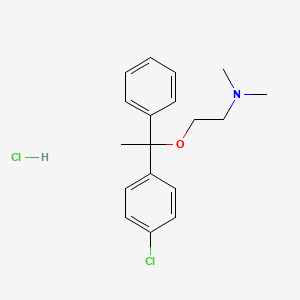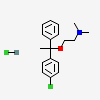Chlorphenoxamine Hydrochloride
- Chlorphenoxamine hydrochloride
- 562-09-4
- Phenoxene
- Chlorphenoxamine HCl
- Systral
- Create:2005-08-08
- Modify:2025-01-18

- chlorphenoxamine
- chlorphenoxamine hydrochloride
- Systral
- Chlorphenoxamine hydrochloride
- 562-09-4
- Phenoxene
- Chlorphenoxamine HCl
- Systral
- Clorevan
- Contristamine, hydrochloride
- EINECS 209-227-1
- Substanz NR. 1766 [German]
- Substanz NR. 1766
- Allergex (TN)
- UNII-5I159322PY
- Chlorphenoxamine hydrochloride [USP]
- 5I159322PY
- Chlorphenoxamine (hydrochloride)
- CHLORPHENOXAMINE HYDROCHLORIDE (200 MG)
- 2-(alpha-(p-Chlorophenyl)-alpha-methylbenzyloxy)-N,N-dimethylethylamine
- 2-((p-Chloro-alpha-methyl-alpha-phenylbenzyl)oxy)-N,N-dimethylamine hydrochloride
- 2-[1-(4-chlorophenyl)-1-phenylethoxy]-N,N-dimethylethanamine hydrochloride
- Ethanamine, 2-(1-(4-chlorophenyl)-1-phenylethoxy)-N,N-dimethyl-, hydrochloride
- Ethenamine, 2-(1-(4-chlorophenyl)-1-phenylethoxy)-N,N-dimethyl-, hydrochloride
- 2-((p-Chloro-alpha-methyl-alpha-phenylbenzyl)oxy)-N,N-dimethylethylamine hydrochloride
- CHLORPHENOXAMINE HYDROCHLORIDE [MI]
- CHLORPHENOXAMINE HYDROCHLORIDE [MART.]
- CHLORPHENOXAMINE HYDROCHLORIDE [WHO-DD]
- Ethylamine, 2-((p-chloro-alpha-methyl-alpha-phenylbenzyl)oxy)-N,N-dimethyl-, hydrochloride
- Phenoxene hydrochloride
- Chlorphenoxamine hydrochloride (USP)
- 2-((P-CHLORO-.ALPHA.-METHYL-.ALPHA.-PHENYLBENZYL)OXY)-N,N-DIMETHYLETHYLAMINE HYDROCHLORIDE
- CHLORPHENOXAMINE HYDROCHLORIDE (MART.)
- Allergex
- Contristamine Hydrochloride
- (1-(p-Chlorophenyl)-1-phenyl)ethyl (beta-dimethylaminoethyl) ether hydrochloride
- beta-Dimethylaminoethyl (p-chloro-alpha-methylbenzhydryl) ether hydrochloride
- SCHEMBL125112
- CHEMBL2105980
- DTXSID80971587
- PAQUKACYLLABHB-UHFFFAOYSA-N
- GLXC-20407
- NS00080030
- D07684
- Q27262251
- 2-[1-(4-chlorophenyl)-1-phenylethoxy]-N,N-dimethylethanamine;hydrochloride
- (1-(P-CHLOROPHENYL)-1-PHENYL)ETHYL (.BETA.-DIMETHYLAMINOETHYL) ETHER HYDROCHLORIDE
- 2-[1-(4-Chlorophenyl)-1-phenylethoxy]-N,N-dimethylethan-1-amine--hydrogen chloride (1/1)
- Ethanamine, 2-(1-(4-chlorophenyl)-1-phenylethoxy)-N,N-dimethyl-, hydrochloride (9CI)

P264, P270, P301+P317, P330, and P501
(The corresponding statement to each P-code can be found at the GHS Classification page.)
Aggregated GHS information provided per 40 reports by companies from 1 notifications to the ECHA C&L Inventory.
Information may vary between notifications depending on impurities, additives, and other factors. The percentage value in parenthesis indicates the notified classification ratio from companies that provide hazard codes. Only hazard codes with percentage values above 10% are shown.
Patents are available for this chemical structure:
https://patentscope.wipo.int/search/en/result.jsf?inchikey=PAQUKACYLLABHB-UHFFFAOYSA-N
- CAS Common ChemistryLICENSEThe data from CAS Common Chemistry is provided under a CC-BY-NC 4.0 license, unless otherwise stated.https://creativecommons.org/licenses/by-nc/4.0/Chlorphenoxamine hydrochloridehttps://commonchemistry.cas.org/detail?cas_rn=562-09-4
- ChemIDplusChlorphenoxamine hydrochloride [USP]https://pubchem.ncbi.nlm.nih.gov/substance/?source=chemidplus&sourceid=0000562094ChemIDplus Chemical Information Classificationhttps://pubchem.ncbi.nlm.nih.gov/source/ChemIDplus
- EPA DSSTox2-[1-(4-Chlorophenyl)-1-phenylethoxy]-N,N-dimethylethan-1-amine--hydrogen chloride (1/1)https://comptox.epa.gov/dashboard/DTXSID80971587CompTox Chemicals Dashboard Chemical Listshttps://comptox.epa.gov/dashboard/chemical-lists/
- European Chemicals Agency (ECHA)LICENSEUse of the information, documents and data from the ECHA website is subject to the terms and conditions of this Legal Notice, and subject to other binding limitations provided for under applicable law, the information, documents and data made available on the ECHA website may be reproduced, distributed and/or used, totally or in part, for non-commercial purposes provided that ECHA is acknowledged as the source: "Source: European Chemicals Agency, http://echa.europa.eu/". Such acknowledgement must be included in each copy of the material. ECHA permits and encourages organisations and individuals to create links to the ECHA website under the following cumulative conditions: Links can only be made to webpages that provide a link to the Legal Notice page.https://echa.europa.eu/web/guest/legal-noticeChlorphenoxamine hydrochloridehttps://echa.europa.eu/substance-information/-/substanceinfo/100.008.389Chlorphenoxamine hydrochloride (EC: 209-227-1)https://echa.europa.eu/information-on-chemicals/cl-inventory-database/-/discli/details/100429
- FDA Global Substance Registration System (GSRS)LICENSEUnless otherwise noted, the contents of the FDA website (www.fda.gov), both text and graphics, are not copyrighted. They are in the public domain and may be republished, reprinted and otherwise used freely by anyone without the need to obtain permission from FDA. Credit to the U.S. Food and Drug Administration as the source is appreciated but not required.https://www.fda.gov/about-fda/about-website/website-policies#linkingCHLORPHENOXAMINE HYDROCHLORIDEhttps://gsrs.ncats.nih.gov/ginas/app/beta/substances/5I159322PY
- ChEMBLLICENSEAccess to the web interface of ChEMBL is made under the EBI's Terms of Use (http://www.ebi.ac.uk/Information/termsofuse.html). The ChEMBL data is made available on a Creative Commons Attribution-Share Alike 3.0 Unported License (http://creativecommons.org/licenses/by-sa/3.0/).http://www.ebi.ac.uk/Information/termsofuse.html
- KEGGLICENSEAcademic users may freely use the KEGG website. Non-academic use of KEGG generally requires a commercial licensehttps://www.kegg.jp/kegg/legal.htmlAnatomical Therapeutic Chemical (ATC) classificationhttp://www.genome.jp/kegg-bin/get_htext?br08303.kegTarget-based classification of drugshttp://www.genome.jp/kegg-bin/get_htext?br08310.keg
- NCI Thesaurus (NCIt)LICENSEUnless otherwise indicated, all text within NCI products is free of copyright and may be reused without our permission. Credit the National Cancer Institute as the source.https://www.cancer.gov/policies/copyright-reuseNCI Thesaurushttps://ncit.nci.nih.gov
- Springer Nature
- Wikidatachlorphenoxamine hydrochloridehttps://www.wikidata.org/wiki/Q27262251
- PubChem
- Medical Subject Headings (MeSH)LICENSEWorks produced by the U.S. government are not subject to copyright protection in the United States. Any such works found on National Library of Medicine (NLM) Web sites may be freely used or reproduced without permission in the U.S.https://www.nlm.nih.gov/copyright.htmlchlorphenoxaminehttps://www.ncbi.nlm.nih.gov/mesh/67100100Muscarinic Antagonistshttps://www.ncbi.nlm.nih.gov/mesh/68018727Histamine Antagonistshttps://www.ncbi.nlm.nih.gov/mesh/68006633
- GHS Classification (UNECE)GHS Classification Treehttp://www.unece.org/trans/danger/publi/ghs/ghs_welcome_e.html
- NORMAN Suspect List ExchangeLICENSEData: CC-BY 4.0; Code (hosted by ECI, LCSB): Artistic-2.0https://creativecommons.org/licenses/by/4.0/NORMAN Suspect List Exchange Classificationhttps://www.norman-network.com/nds/SLE/
- MolGenieMolGenie Organic Chemistry Ontologyhttps://github.com/MolGenie/ontology/
- PATENTSCOPE (WIPO)SID 395504027https://pubchem.ncbi.nlm.nih.gov/substance/395504027


 CID 6475 (Chlorphenoxamine)
CID 6475 (Chlorphenoxamine) CID 313 (Hydrochloric Acid)
CID 313 (Hydrochloric Acid)